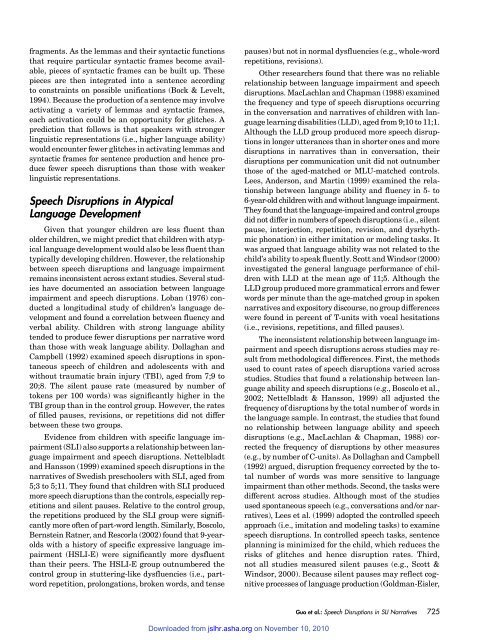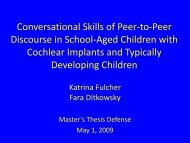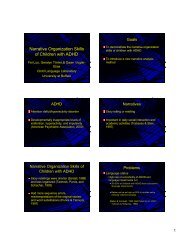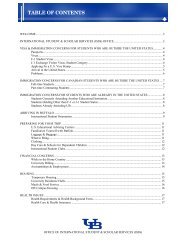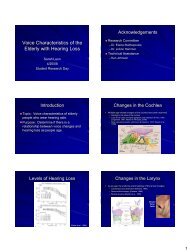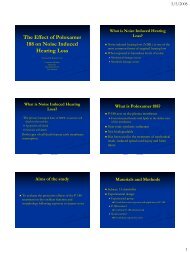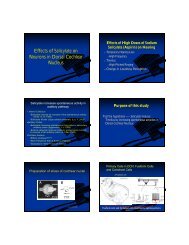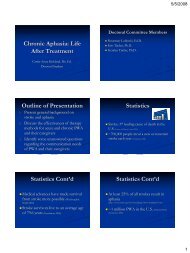Speech Disruptions in the Narratives of English-Speaking Children ...
Speech Disruptions in the Narratives of English-Speaking Children ...
Speech Disruptions in the Narratives of English-Speaking Children ...
You also want an ePaper? Increase the reach of your titles
YUMPU automatically turns print PDFs into web optimized ePapers that Google loves.
fragments. As <strong>the</strong> lemmas and <strong>the</strong>ir syntactic functions<br />
that require particular syntactic frames become available,<br />
pieces <strong>of</strong> syntactic frames can be built up. These<br />
pieces are <strong>the</strong>n <strong>in</strong>tegrated <strong>in</strong>to a sentence accord<strong>in</strong>g<br />
to constra<strong>in</strong>ts on possible unifications (Bock & Levelt,<br />
1994). Because <strong>the</strong> production <strong>of</strong> a sentence may <strong>in</strong>volve<br />
activat<strong>in</strong>g a variety <strong>of</strong> lemmas and syntactic frames,<br />
each activation could be an opportunity for glitches. A<br />
prediction that follows is that speakers with stronger<br />
l<strong>in</strong>guistic representations (i.e., higher language ability)<br />
would encounter fewer glitches <strong>in</strong> activat<strong>in</strong>g lemmas and<br />
syntactic frames for sentence production and hence produce<br />
fewer speech disruptions than those with weaker<br />
l<strong>in</strong>guistic representations.<br />
<strong>Speech</strong> <strong>Disruptions</strong> <strong>in</strong> Atypical<br />
Language Development<br />
Given that younger children are less fluent than<br />
older children, we might predict that children with atypical<br />
language development would also be less fluent than<br />
typically develop<strong>in</strong>g children. However, <strong>the</strong> relationship<br />
between speech disruptions and language impairment<br />
rema<strong>in</strong>s <strong>in</strong>consistent across extant studies. Several studies<br />
have documented an association between language<br />
impairment and speech disruptions. Loban (1976) conducted<br />
a longitud<strong>in</strong>al study <strong>of</strong> children’s language development<br />
and found a correlation between fluency and<br />
verbal ability. <strong>Children</strong> with strong language ability<br />
tended to produce fewer disruptions per narrative word<br />
than those with weak language ability. Dollaghan and<br />
Campbell (1992) exam<strong>in</strong>ed speech disruptions <strong>in</strong> spontaneous<br />
speech <strong>of</strong> children and adolescents with and<br />
without traumatic bra<strong>in</strong> <strong>in</strong>jury (TBI), aged from 7;9 to<br />
20;8. The silent pause rate (measured by number <strong>of</strong><br />
tokens per 100 words) was significantly higher <strong>in</strong> <strong>the</strong><br />
TBI group than <strong>in</strong> <strong>the</strong> control group. However, <strong>the</strong> rates<br />
<strong>of</strong> filled pauses, revisions, or repetitions did not differ<br />
between <strong>the</strong>se two groups.<br />
Evidence from children with specific language impairment<br />
(SLI) also supports a relationship between language<br />
impairment and speech disruptions. Nettelbladt<br />
and Hansson (1999) exam<strong>in</strong>ed speech disruptions <strong>in</strong> <strong>the</strong><br />
narratives <strong>of</strong> Swedish preschoolers with SLI, aged from<br />
5;3 to 5;11. They found that children with SLI produced<br />
more speech disruptions than <strong>the</strong> controls, especially repetitions<br />
and silent pauses. Relative to <strong>the</strong> control group,<br />
<strong>the</strong> repetitions produced by <strong>the</strong> SLI group were significantly<br />
more <strong>of</strong>ten <strong>of</strong> part-word length. Similarly, Boscolo,<br />
Bernste<strong>in</strong> Ratner, and Rescorla (2002) found that 9-yearolds<br />
with a history <strong>of</strong> specific expressive language impairment<br />
(HSLI-E) were significantly more dysfluent<br />
than <strong>the</strong>ir peers. The HSLI-E group outnumbered <strong>the</strong><br />
control group <strong>in</strong> stutter<strong>in</strong>g-like dysfluencies (i.e., partword<br />
repetition, prolongations, broken words, and tense<br />
pauses) but not <strong>in</strong> normal dysfluencies (e.g., whole-word<br />
repetitions, revisions).<br />
O<strong>the</strong>r researchers found that <strong>the</strong>re was no reliable<br />
relationship between language impairment and speech<br />
disruptions. MacLachlan and Chapman (1988) exam<strong>in</strong>ed<br />
<strong>the</strong> frequency and type <strong>of</strong> speech disruptions occurr<strong>in</strong>g<br />
<strong>in</strong> <strong>the</strong> conversation and narratives <strong>of</strong> children with language<br />
learn<strong>in</strong>g disabilities (LLD), aged from 9;10 to 11;1.<br />
Although <strong>the</strong> LLD group produced more speech disruptions<br />
<strong>in</strong> longer utterances than <strong>in</strong> shorter ones and more<br />
disruptions <strong>in</strong> narratives than <strong>in</strong> conversation, <strong>the</strong>ir<br />
disruptions per communication unit did not outnumber<br />
those <strong>of</strong> <strong>the</strong> aged-matched or MLU-matched controls.<br />
Lees, Anderson, and Mart<strong>in</strong> (1999) exam<strong>in</strong>ed <strong>the</strong> relationship<br />
between language ability and fluency <strong>in</strong> 5- to<br />
6-year-old children with and without language impairment.<br />
They found that <strong>the</strong> language-impaired and control groups<br />
did not differ <strong>in</strong> numbers <strong>of</strong> speech disruptions (i.e., silent<br />
pause, <strong>in</strong>terjection, repetition, revision, and dysrhythmic<br />
phonation) <strong>in</strong> ei<strong>the</strong>r imitation or model<strong>in</strong>g tasks. It<br />
was argued that language ability was not related to <strong>the</strong><br />
child’s ability to speak fluently. Scott and W<strong>in</strong>dsor (2000)<br />
<strong>in</strong>vestigated <strong>the</strong> general language performance <strong>of</strong> children<br />
with LLD at <strong>the</strong> mean age <strong>of</strong> 11;5. Although <strong>the</strong><br />
LLD group produced more grammatical errors and fewer<br />
words per m<strong>in</strong>ute than <strong>the</strong> age-matched group <strong>in</strong> spoken<br />
narratives and expository discourse, no group differences<br />
were found <strong>in</strong> percent <strong>of</strong> T-units with vocal hesitations<br />
(i.e., revisions, repetitions, and filled pauses).<br />
The <strong>in</strong>consistent relationship between language impairment<br />
and speech disruptions across studies may result<br />
from methodological differences. First, <strong>the</strong> methods<br />
used to count rates <strong>of</strong> speech disruptions varied across<br />
studies. Studies that found a relationship between language<br />
ability and speech disruptions (e.g., Boscolo et al.,<br />
2002; Nettelbladt & Hansson, 1999) all adjusted <strong>the</strong><br />
frequency <strong>of</strong> disruptions by <strong>the</strong> total number <strong>of</strong> words <strong>in</strong><br />
<strong>the</strong> language sample. In contrast, <strong>the</strong> studies that found<br />
no relationship between language ability and speech<br />
disruptions (e.g., MacLachlan & Chapman, 1988) corrected<br />
<strong>the</strong> frequency <strong>of</strong> disruptions by o<strong>the</strong>r measures<br />
(e.g., by number <strong>of</strong> C-units). As Dollaghan and Campbell<br />
(1992) argued, disruption frequency corrected by <strong>the</strong> total<br />
number <strong>of</strong> words was more sensitive to language<br />
impairment than o<strong>the</strong>r methods. Second, <strong>the</strong> tasks were<br />
different across studies. Although most <strong>of</strong> <strong>the</strong> studies<br />
used spontaneous speech (e.g., conversations and/or narratives),<br />
Lees et al. (1999) adopted <strong>the</strong> controlled speech<br />
approach (i.e., imitation and model<strong>in</strong>g tasks) to exam<strong>in</strong>e<br />
speech disruptions. In controlled speech tasks, sentence<br />
plann<strong>in</strong>g is m<strong>in</strong>imized for <strong>the</strong> child, which reduces <strong>the</strong><br />
risks <strong>of</strong> glitches and hence disruption rates. Third,<br />
not all studies measured silent pauses (e.g., Scott &<br />
W<strong>in</strong>dsor, 2000). Because silent pauses may reflect cognitive<br />
processes <strong>of</strong> language production (Goldman-Eisler,<br />
Downloaded from jslhr.asha.org on November 10, 2010<br />
Guo et al.: <strong>Speech</strong> <strong>Disruptions</strong> <strong>in</strong> SLI <strong>Narratives</strong> 725


